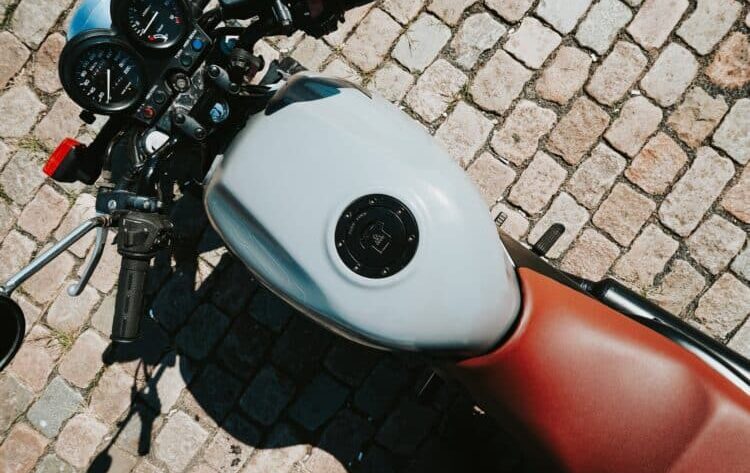Cleaning a motorcycle gas tank that has got all the damage from rust and moisture is not a fun task to take part in. However, it is absolutely necessary if you want an extended life for your beloved bike.
Naturally forming condensation and mechanical abrasive material contribute to regular mild rusting of motorcycle tanks.
The task of cleaning a rusted motorcycle tank is not very complex and at the same time not very simple. You need the right knowledge and the information to carry on the task without causing any damage to yourself or the tank. This is important because you will be dealing with a lot of chemicals and mild acid.
Replacing fuel filters or securing an old tank with a fuel soluble sealer is a good way to start in cases of emergencies.
So, let’s get started and help you clean your motorcycle’s gas tank –
6 Steps to Clean Your Motorcycle Gas Tank
- Dismount the Fuel Tank to Identify Overall Motorcycle Damage
- Choose Appropriate Rust Removal Cleaning Process for the Motorcycle
- Repair and Prepare the Tank
- Acid Wash, Agitator, and Shake & Clean Your Motorcycle
- Flush to Finish
- Check for Complications
Dismount the Fuel Tank to Identify Overall Motorcycle Damage

The first thing you need to do is remove the gas chamber compartment from your bike. You can drain all the gasoline, let it remain in the tank or save it in a bottle depending on what you think will be easier for you.
Once the tank has been removed, take a good look at its exterior and see if there are any dents that could prevent proper cleaning later on. Also, inspect the welds and see if they’re sturdy enough to hold once everything is done and put back together again.
Impurities such as heavy rust deposits and moisture not only affect the appearance of your gas tank but also corrode its parts and slow down its performance. If left unattended, these effects may lead to serious damages in some cases! That’s why we recommend having a professional mechanic inspect your fuel filter and chamber to help you determine its damage and life expectancy.
If you see that the gas tank is more than 90% damaged, it’s better that you don’t waste your time and money because in that case, you will need to replace the tank as no fixing can solve the issue.
Choose Appropriate Rust Removal Cleaning Process for the Motorcycle

After you have deemed that the tank is fit to be cleaned and have assessed the damage caused by rust and moisture, it is time to remove all the rust from your rusted gas tank!
Of course, this is not a simple task considering how small many of the holes that rust may have created in your motorcycle’s gas tank.
Many mechanics recommend using electrolysis for cleaning rust on gasoline tanks.
However, they do not always know that there are other ways too – Attach an agitator to a power drill and fill it with a baking soda water solution. Add vinegar or salt into warm water and then pour both solutions into another container. After you mix them together, you need to place this container inside the metal one. Then you need to turn on the drill and start scrubbing. After that, you can rinse and then repeat Steps 2 to 5 until you scavenge all of the rust.
After the rust gets abated, you can apply a coat of oil or rust paint.
This works not only for gas tanks but also for rusty bumpers and fenders. The chemical reaction between the salt, baking soda, and vinegar works exceptionally fine and removes the rust from your rusted gas tank.
Repair and Prepare the Tank

After you’ve removed all the rust from your gas tank, it is time to make sure that no moisture remains inside. You can do this by drying out your tank with compressed air.
However, if there are still some small holes in your tank, which we think there will be since most gasoline tanks have many small holes on their surfaces, then you need to seal them up too because once again moisture may reappear and corrode the metal.
Lighter gauge metal and accurate rust abatement techniques extend the life of the fuel filters, gas cap and fuel valves of the motorcycle. Abrasive material damage not only the tank but the motor oil too.
You can use a sealant, JB Weld, silicone plugs and an accurate abatement process to fix the holes until you get your gas tank repaired and sealed by a professional.
Acid Wash, Agitator, and Shake & Clean Your Motorcycle
After you have prepared the tank, it is time to start cleaning it with acid!
Many mechanics recommend using muriatic acid for this task as it is very effective in removing all the paint, grease, and dirt. However, if you’re not comfortable using this type of acid then you can replace it with phosphoric acid.
Make sure that you wear protective gear while working with these acids – safety goggles, gloves, and a mask.
Pour the acid into a plastic container and attach the agitator.
Place the container inside the tank and start shaking it for about 10 minutes. Make sure that you do this in a well-ventilated area as the fumes can be harmful.
After you have agitated the tank with the acid, remove the container and rinse it with water. Now, it is time to repeat these steps until you are satisfied with the results.
You may also use a brush to help clean those hard-to-reach areas.
Flush to Finish
The final step is to flush the tank with water and then seal it up for good.
You can use a garden hose to do this or you can take it to a professional who will use a machine to clean it for you.
After you have completed these steps, your gas tank should be looking and performing better than ever before! Just make sure that you keep an eye on it in case any new rust or moisture appears.
Check for Complications
After you have cleaned and restored your motorcycle’s gas tank, it is important to check for any possible complications that may have arisen as a result of the cleaning.
Make sure that you check for leaks and also for any damage that may have been caused by the acid or rust removal process.
If you find any problems, take your bike to the mechanic and have them take a look. It is always better to be safe than sorry when it comes to your motorcycle!
Conclusion
Cleaning your motorcycle’s gas tank can seem like a daunting task, but if you follow these simple steps, you will be able to do it yourself in no time! Make sure that you remove all the rust, prepare the tank for cleaning, and flush it with water before sealing it up. After you have completed these steps, your gas tank should be looking and performing better than ever before! Just make sure that you keep an eye on it in case any new rust or moisture appears.
Always remember, that it is very important to clean your motorcycle’s gas tank on a regular basis to prevent corrosion and other damages. If you are not comfortable doing this yourself, please take it to a professional mechanic.
Experts offer rust abatement services, install commercial tank sealers and inspect for different motorcycle components such as the fuel cap gasket, fuel tank, vacuum caps, fuel filters, gas cap and more.
After you complete cleaning your gas tank and when you will see it working fine, the level of satisfaction that you will have after working successfully on your bike is incomparable to any other joy.
So, get started with these tips!






